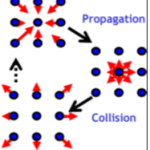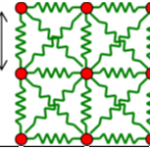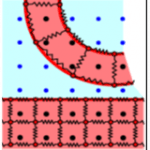Lattice Boltzmann method
The lattice Boltzmann model (LBM) is a lattice-based method for simulating hydrodynamic flows. Unlike conventional numerical methods that involve a discretization of the continuum equations, LBM use fluid “particles” that propagate along a fixed in space lattice to simulate behavior of the fluids. The model consists of two processes, the first being the propagation of fluid particles to neighboring lattice sites, and the second being collisions between particles when they reach a site.
Lattice spring method
The lattice spring model (LSM) is a mesoscale method for modeling the micromechanics of solid, elastic materials. LSM consists of a network of harmonic springs that connect regularly spaced mass points or nodes. To capture the dynamics of the solid material, we sum all forces acting on a specific node and then numerically integrate the Newton equation of motion for each node on the lattice.
Hybrid LBM/LSM
To study engineering problems involving dynamic interactions between the fluids and elastic solids, we use the hybrid LBM/LSM approach, which combines LBM and LSM via appropriate boundary conditions. The velocities of lattice spring nodes situated at the solid-fluid interface are transmitted to the surrounding fluids. In turn, these LSM nodes experience forces due to the fluid pressure and viscous stresses at the interface.
Dissipative particle dynamics
The dissipative particle dynamics (DPD) is a model for coarse-grained molecular dynamic (MD) simulations that is able to capture hydrodynamic interactions. DPD uses soft repulsive interactions between particles representing clusters of molecules and allows for simulations of physical phenomena occurring at time scales many orders of magnitude greater than the captured by MD.
Volume-of-fluid method
The volume-of-fluid (VOF) method is a numerical approach for solving multiphase flows with moving interfaces. To track the interface between two phases, a color function is introduced that is equal to 1 within one phase and to 0 within the other phase. The evolution of the color function is calculated using a transport equation. Then a reconstruction procedure is employed to find the location of the interface. The effect of the surface tension is introduced through the continuum surface force approach.

